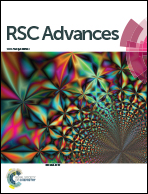Superacid mediated intramolecular condensation: facile synthesis of indenones and indanones†
Abstract
Superacid promoted intramolecular acylation is described for the synthesis of indenones. Interestingly, in all resulting indenones, the olefin bond is rearranged to the exo position of the five membered rings. Significantly, the method is further applied to the synthesis of indanones via the formation of two C–C bonds by in situ treatment of indenones with an external arene, in one-pot. Most importantly, the present sequential method for the synthesis of indanones is advantageous, as it limits even more electron rich external arenes only to the Friedel–Crafts alkylation. This is not possible in previous reports wherein both cinnamic acid ester and the external arenes are treated together in the presence of an acid, wherein the relatively more reactive arene is preferred to facilitate the acylation step.


 Please wait while we load your content...
Please wait while we load your content...